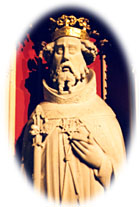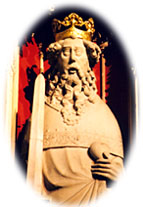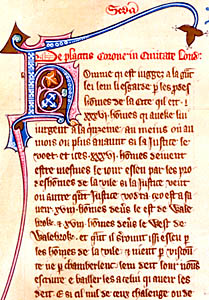| CONSTITUTION | ||
"Whenever people begin to associate together in some kind of communal life, rules of conduct have to be devised to maintain peace and order. Such rules are rarely committed to writing, but they are faithfully remembered and handed down from one generation to another as the 'folk-law' or 'custom' of the people."
[G.O. Sayles, The Medieval Foundations of England, London: Methuen, 1948, 122]
If we allow that towns had the two fundamental roles of trading centre and of administrative unit for a defined community – in terms of providing for common needs while protecting individual rights, and of ensuring communal obligations to higher authorities were met – we should expect to see related concerns addressed through customary laws, when they eventually come to be written down (for Professor Sayles was speaking of the Anglo-Saxon period). And so it is. From the twelfth century, these customs were supplemented by specifications from the king, or other lord of a town, as to the scope of local jurisdiction. Together, such grants or recognitions of privileges and authority and the developing set of local by-laws, which emerged partly out of custom and partly out of the exercise of granted authority in response to new problems and challenges, formed what might be considered the urban constitution.
Before we proceed, there are two important and related points that must be understood about this constitution. First, in a so-called feudal society the exemptions, powers, and jurisdictions of urban communities set out in charters of liberties were, strictly speaking, contractual privileges, subject to suspension or withdrawal by the lordly grantor, rather than inalienable rights (although the two terms are used rather loosely in the discussion below). The situation is not so straightforward for local customs, which developed over time in less well-documented circumstances, although became wrapped up with seigneurial recognition of urban status. Second, in England the characteristic freedoms acquired by towns came not through revolution, for the most part. Initially they came from an unspoken recognition by grantors and grantees that, in an economic landscape where commerce was at first supplementing and then gradually supplanting, land, and the relative self-sufficiency it offered, as the most lucrative source of income, such freedoms were to mutual benefit and could be expected to fuel the urban engine of economic development. Subsequently, such freedoms amplified in breadth and depth through the interplay, and indeed tension, between the determination, on the one hand, of townsmen (or at least those of their number who governed) to push the envelope of independence from external authorities and, on the other hand, of the monarchy to make better use of the towns in its efforts to extend centralized legal and fiscal control nation-wide.
It is not clear whether, before the twelfth century, towns had any officially recognized powers relating to communal self-government, or any special privileges that definitively distinguished the personal status of their inhabitants from those of non-urban areas, with the possible exceptions of holding property in exchange for money rents rather than personal services, and (less certainly) in exemptions from paying tolls on merchandize. However, there was certainly some differentiation of town and countryside within the royal administrative system, and royal patronage, whose parameters are not easily defined, probably helped a number of trading settlements prosper and develop into towns.
The folkmoot must have provided a mechanism for the discussion of local concerns in a way that allowed for expression of aspirations and ambitions. Merchant gilds, where they existed, likely provided another and perhaps more important focus for such discussions, and even for the momentum behind the acquisition of royal charters, since they may already have been instrumental in the local regulation of commercial affairs, and since their members were those townspeople with the most to gain; this would help explain why such gilds were among the earlier privileges to be confirmed by charter. Later, attention turned more to building up the jurisdiction of the town court, where it was under the presidency of officers elected by the community, and/or to establishing mayors and councils as administrative authorities with no direct accountability to higher powers.
Certain aspects of urban administration, society and economic affairs were influenced by local customs, which varied from place to place. But the character, origin and antiquity of such customs is difficult to judge in the absence of written records; royal charters make reference to their existence, but without (in most cases) specifically indicating what they were. Only so much can be gleaned on this subject from the Domesday Book, which gives our best single view of towns prior to the appearance of royal bureaucratic records series in the twelfth century.
That century too is hardly rich in written records relevant to urban history. There are a few documents in the form of royal charter grants to a handful of towns – not all of them accepted unquestioningly by historians as authentic – and the Exchequer Pipe Rolls (recording information about the farm and other payments made from the towns). But, other than some private charters related to real estate transactions, no documents directly from the towns themselves until the very end of the century. It does not appear, and we should not be too surprised at the fact, that any effort was made to record local customs until local self-government – and perhaps more than local government, local bureaucracy – started to take shape as the thirteenth century progressed. By which time we cannot be certain to what extent the formulated customs reflect earlier practice.
The consequence of this paucity of documentation is that, while we are able to reconstruct with some confidence the broad framework of the development of the urban constitution in its early period, we have little direct evidence of the thinking behind that course of development. The account of the setting up of administrative mechanisms at Ipswich in 1200 – itself prompted by the grant of a royal charter – is a rare and thereby important window onto urban affairs even though, since known only from a later copies, not entirely free of suspicion. Consequently, historians must rely heavily on hypothesis to piece together the fragmentary evidence.
One of the fundamental sources of evidence about the borough constitution are royal charters granting liberties (the term franchises being more commonly used today): privileges related principally to aspects of self-government, i.e. independence from other administrative systems or jurisdictions, and special rights that gave consideration to the particular character and needs of an urban community. The grants were made usually in return for a lump-sum payment and agreement by the representatives of the local community to make a yearly payment – the fee farm – to compensate the king for revenues he would be giving up by turning over administration powers to the borough, e.g. market tolls. Paralleling the charters of liberties granted by the king were similar grants made by lesser lords – known as "mesne lords" because they stood as intermediaries in lordship between the king and his subjects – to boroughs they controlled. Typically these lords, or the burgesses themselves, would seek confirmation from the king of such grants.
 |
 |
|
The earliest charters of liberties were granted
by Henry I (upper
left) and Henry II
(upper right),
cautiously allowing towns some responsibility for their own affairs.
Richard I (lower
left) and John
(lower right),
in need of money, were more liberal in selling towns the privileges they
sought. Late 15th century statuary from the choir screen in York Minster. Photos © S. Alsford |
|
 |
 |
Early students of English urban history relied heavily on these charters as indicators of the scope of self-government and as causes of urban growth. Today, historians place much less emphasis on such documents, no longer considering them the principal instruments defining urban status, although this is perhaps partly a reaction against the over-emphasis given by earlier generations. While the formal concessions of privileges by the king, or other lord of the borough, were valuable tools in the process of urban development, they were not indispensable, and in some ways were more markers of a stage in that development, consolidating powers which had sometimes been informally exercised (or usurped) prior to their official recognition in the charters. One example is the privilege known as "return of writs", whereby the county sheriff could not personally carry out royal directives that applied to towns, but had to pass the written commands along to the town officials, who then had to make a written return confirming that they had fulfilled the instructions. Some historians made much of this supposed advance in freedom, and it is true that there were a flurry of such grants in the mid-1250s, although that owes something to Henry III's need, in view of the growing baronial opposition, to curry favour with his towns. It is now known, however, that this procedure was in practice prior to the charter grants. In that light the grants appear more to formalize an existing situation, or even to control its applicability via definition. The Quo Warranto enquiries begun in the late thirteenth century to investigate the franchises claimed by local landlords and authorities gave additional motivation to towns to have their claims recognized via royal charters; apart from the instance mentioned above, the charters of Henry III and Edward I in fact did not extend much beyond acknowledging the powers and privileges granted by their predecessors.
Although we should not discount the early role of regional lords in obtaining royal grants for new towns they had established on their domains – such charters not necessarily even acknowledging the identity of the seigneurial founder – on the whole, and particularly as time went on, the initiative for charters, whether they confirmed existing rights or granted new ones, came largely from the towns themselves. The gains made by some towns, notably London, appear to have stimulated copycat efforts by others. While much of what they permitted was in the interest of the development of local government within the broader framework of a national system of government answerable to the monarchy, England's kings were anxious to avoid stimulating the level of autonomy found in some places in continental Europe. Charter terms, if not their wording, were most probably – particularly in the later period – drafted by town representatives, or at least reflected what the townsmen asked for in written petitions (few of which have survived); although we should envisage charters as a product of negotiation between local and central governments, so that the end-result served the interests of both. But because the final text of the charters was drawn up by clerks of the central government, which had an interest both in controlling the extent of urban independence and in ensuring some consistency in the powers accorded to the different boroughs, and because of a strong tendency to use charters granted to the earlier recipients as models for those granted to later recipients, historians have to beware of taking the precise wording at face value.
Nonetheless, the earliest royal charters to towns are important sources of evidence simply because of the paucity of documentation produced by, or surviving from, the towns themselves, especially prior to the fourteenth century. Many of the later charters were little more than reiterations of the earlier, sometimes with a few additions, largely because towns felt it advisable to purchase inspections and confirmations of their privileges from each new king coming to the throne. Only in this way could towns perpetuate their rights before formal incorporation – and even after incorporation made renewal unnecessary, attachment to tradition prompted towns to continue to seek royal confirmations. Royal charters were, in essence, the legal warrant or mandate by the country's highest authority for the existence of borough government and for the scope of its authority (prior to the regularization of borough powers through the Municipal Corporations Act of 1835). These charters were usually issued under the great seal. However, grants of minor privileges or mere confirmations of charters came increasingly to be issued as letters patent.
The charters are perhaps most useful for giving us an overview of the stages in evolution of the borough constitution, and of the growing ambitions of the borough community to assert control of its internal affairs and eliminate the interference of "foreign" authorities, such as shire officials or other officers of the royal administration. As a generalization, we can say that the early charters, of twelfth and thirteenth centuries, acted to differentiate town and countryside in terms of distinctive rights (particularly tenurial rights), to establish the basic mechanisms for administration (e.g. court, officers, merchant gild), to begin the process of making those mechanisms semi-independent of external authorities, and to foster the centralization of commerce in towns through advantageous privileges. Later charters of the fourteenth and fifteenth centuries, if not dealing with local issues, added only a few significant developments, by:
At the same time they integrated towns more into the emerging system of national administration, while widening the growing gulf between rulers and ruled by giving support to constitutional forms which undermined democratic principles. It is important we not confuse "self-government" with "autonomy"; while factions in one or two towns at points in the twelfth and thirteenth centuries may have harboured notions of setting themselves up as communes on the continental model, the mainstream of constitutional development was in the direction of urban authorities taking on administrative responsibilities that freed them from outside interference by certain officials, but made them more directly accountable to the king.
In the broader sense, "customs" refers to a set of both traditional privileges and traditional obligations, the latter largely in the form of monetary payments, although services are also evidenced. The administration of the privileges in most cases was associated with tolls, judicial fines, rents, or licence fees which found their way into royal coffers. "Customs" is found in documents sometimes referring to the dues, and sometimes to the privileges which were for generations preserved in communal memory, until the acquisition of local self-government provided the impetus and the administrative mechanisms to write them down. By that time it has become difficult to be sure which of the customs are ancient, which recent; which heark back to Anglo-Saxon times, and which may have been imported by the Normans.
It is also difficult to know to what extent the customs were of purely local derivation. Certainly the numerous custumals that have survived to us display some individuality, eclecticism, and idiosyncracy. Yet there are enough similarities from town to town to suggest at least indirect influence, through an exchange of knowledge – perhaps no more than the result of the travelling merchant as agent of communication – and in some cases deliberate imitation, although direct copying from one town's custumal to another's is rarely apparent. In some cases, customs appear to heark back to Anglo-Saxon or Danish law and this may explain some of the commonality between urban usages.
If charters of liberties provided a framework for the borough constitution, it was for the custumals compiled by the burgesses themselves – supplemented by later by-laws (usually referred to as ordinances) – to act as the evolving codex that served as a reference tool for administrators, particularly those presiding over the town courts. Custumals incorporate a range of material:
Examples of entire custumals such – from Norwich, Ipswich and Maldon – are given elsewhere on this site. Some of the early royal charters referred to, and endorsed, existing customary laws without feeling the need to spell out what was already common knowledge to the grantees. Although knowledge might become blurred or subject to changing perspective over time. Ipswich provides us both with an instance of the setting down on parchment of local laws, perhaps from the beginning of urban self-government, and with the creation of a new edition (after the original was lost) out of fear that laws held only in memory were subject to distortion.
Eventually the local customs that governed so many aspects of urban life were superseded as the monarchy sought to establish a national framework of law and legal administration. But for the period when medieval towns were at their apex, perhaps no other single type of document provides us with so fascinating a view of urban life.
 |
Part of a page from the London Liber Albus (Book 1, pt.2, chapter 47), early 14th century, French, stating one of the city customs concerning legal procedures. For another decorated example, see Fordwich's custumal. |
The attainment of urban constitutions instituting self-government – or at least as much self-government as was feasible within the strong and relatively centralized monarchical system of England – has sometimes been portrayed as if essentially a communal ambition attained through the forceful expression of popular will. Even though the traditional grassroots authority of the folkmoot, and sometimes the excitability of the mob, might be harnessed if necessary to the task, peaceful negotiation backed by financial incentive seems to have been the more normal strategy. In this the lead must surely have been taken by particular members of the community willing and able to put up the money required to achieve changes from which they could expect some return on investment. The Ipswich proceedings in 1200 are an uncommon instance where we can put names to those instigators of change, for we may reasonably suspect the identities of at least some of them to lie in the group elected to guide a newly-reconstituted administration through its fledgling year.
The Ipswich proceedings are at pains to portray the new constitutional arrangements as emanating from the unanimous will of the townsmen; but such changes, and the chartered privileges that prompted them, were not necessarily desired by, or to the benefit of, all residents. As complaints from a number of towns later showed, one reform often undertaken by the new local authorities was a more restrictive definition of citizenship, designating some inhabitants as privileged members of the community while leaving others out in the cold. An essay on the foundations of the urban constitution cannot, then, be complete without acknowledging occasional indications of contrary opinion within the community. For example, the effort by some Lynn burgesses to win independence from their episcopal overlord, in part by attempting to harness overriding royal authority, ran up against opposition from other burgesses who, for whatever reason, preferred a policy of loyalty; division between pro-bishop and anti-bishop factions can be seen playing a role in local political conflict from the late thirteenth through the early fifteenth centuries.
At Ipswich itself opposition appears less broadly-based but was nonetheless powerful enough to cause problems. Events there in 1200 may represent, to some degree at least, a changing of the guard, as certain local families which were in the process of building wealth from land exploitation and commerce – possibly with one particular family taking the lead – sought to bolster that process by gaining more influence over local matters. When these up-and-comers took control, it may have been by displacing an older elite whose influence derived more from military and administrative service; such a transition is seen in the development of many continental urban communities, but is much hazier in England. One Elias de Gippewic is known to have served as the king's reeve of Ipswich, presiding in its portmanmoot, probably shortly before King John's charter grant of self-government, which must have deprived Elias of lucrative employment; his name is absent from the list of those set in power in 1200. Whether out of aggrievement, conservative sentiment, or because his own fiscal interests were adversely affected, Elias subsequently complained to the king that the borough authorities had transferred the fish-market from its traditional site to a new one, resulting in a reduction in its value; his complaint set in motion in 1212 a Quo Warranto proceeding, obliging the bailiff and other borough representatives to journey to the king's court to explain themselves. They defended on the grounds that the old site of the market was noisy, that the new site (not far from the grain market in the town centre) was more efficient for collection of tolls payable to the king as part of the fee farm, and that their royal charter of liberties effectively empowered them to make such reforms. This was not the first complaint about the initiatives of the new administration. From the time of its inception, the matter of restricting freedom from toll to burgesses was evidently controversial, and obliged modifications to the policy at various points. And in 1205 a manorial lord of the vicinity brought an action in the king's court, arguing that a dam the burgesses had erected (possibly to divert water into the defensive ditch whose creation the king had recently authorized) had damaged his mill, presumably by depriving it of its power-source. Elias's obstructionism cannot have endeared him to the men now at the helm of Ipswich's government. In 1213 it was his wife's turn to complain to the king, claiming that while en route to market she overheard certain men talking of a plot against the life of her husband; and that not long afterwards Elias, while inspecting his crop in the communal fields, was assaulted by a group of men, one of whom knifed him, of which wound Elias subsequently died. The bailiffs, always anxious to pre-empt the county sheriff becoming involved in local affairs, insisted (dubiously) that the borough court had jurisdiction in such matters – their charter having granted coroners to deal with pleas of the crown. But Alice evidently had no confidence that justice would be obtained from that court's officials, and so appealed to the king.
We must be cautious about thinking of the development of borough self-government as necessarily the outcome of a populist movement pursuing a higher degree of liberty from seigneurial oppression. The interplay between various interests and causal agents, and their differing objectives, is complex; it may have included, at least in some towns, a political struggle between an established urban elite and a rising, mainly mercantile element seeking more control over the development of local conditions affecting the conduct of trade and other matters affecting the accumulation of wealth. We lack the detailed and intimate records necessary to allow us to accurately gauge the politics behind the thrust for self-governing powers. Consequently it is possible to place variant interpretations on such initiatives, as for example in the case of Coventry, where arguments have been made: for divergent and disunited approaches by the residents of the Earl's half and those of the Prior's half, as well as a divide between opponents and supporters of the Prior's lordship; for resort, because of insufficient power to effect change through persuasion, to fraudulent efforts by a clique of community leaders looking to increase their authority; and for a deferral of indépendandiste ambitions because the town's lords had been fostering favourable conditions that already gave enterprising townsmen a satisfactory degree of freedom of economic action. We ought not ignore or downplay the role of both ecclesiastical and secular lords in re-urbanizing England, and of generating an environment in which urban society could prosper. The measured concessions made by lords to burgesses may have been self-interested, in terms of assuring revenue streams without the labour or expense of related administration, but they set towns on a course of development which would in time take them beyond the bonds of lordship, along paths of self-determination and maturation not originally envisaged by town founders.
All this being said, we cannot discount – even though outside of London we may see little of – pressure from below. The fundamental human desire to improve one's lot in life and one's quality of life make it plausible enough that there would have been some measure of popular support for constitutional changes expected to improve prospects. Indeed, it was this desire to build a better life on which town founders were banking when they granted urban conditions attracting immigrants, even though they may not have initially envisaged self-government as an element of those conditions. Whatever the reasons for the emergence of self-governing mechanisms, at different times in different places, once in existence they enabled new initiatives and played a major role, in conjunction with the development of a national government, in shaping both the character of boroughs and, by generating a new level of record-keeping, our knowledge of those boroughs.
BALLARD, Adolphus, ed. British Borough Charters, 1042-1216. Cambridge, 1913.
BALLARD, Adolphus and James TAIT, eds. British Borough Charters, 1216-1307. Cambridge, 1923.
BATESON, Mary. Borough Customs. Selden Society, vols.18 (1904), 21 (1906).
WEINBAUM, Martin, ed. British Borough Charters, 1307-1660. Cambridge, 1943.
See also works in the further reading section of the Introduction to the history of medieval boroughs, especially Tait, Platt and Reynolds.
|
|
 main menu |
|
|
||